|

Scorpion Stinger Spoons

Lake Erie Fishing
Maps

The Official Walleye.com
Lake Erie Walleye
Fishing Hat
|
Precision
Trolling for Erie's Walleyes
Precise
trolling presentations are a critical key to
consistent
success on Lake Erie's walleyes
by Captain Michael Veine
Sometimes Lake
Erie's walleyes will bite just about any bait trolled, drifted or cast. On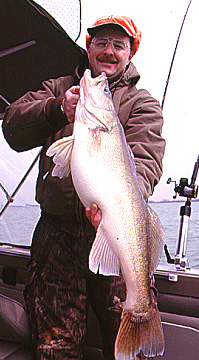 those
rare days, just about everybody catches plenty of fish. However, more times
than not, Erie's walleyes are only going to be caught by savvy anglers using
select baits presented in a particular fashion. Precision trolling often
shines during those tough bites. Electronics can be used to locate fish and
determine what depth they are holding at. It's then just a simple mater of
putting the right baits at the right depth to reap the benefits of a
successful program. those
rare days, just about everybody catches plenty of fish. However, more times
than not, Erie's walleyes are only going to be caught by savvy anglers using
select baits presented in a particular fashion. Precision trolling often
shines during those tough bites. Electronics can be used to locate fish and
determine what depth they are holding at. It's then just a simple mater of
putting the right baits at the right depth to reap the benefits of a
successful program.
Earlier this year my charter customers had been treated to boatloads of hog
walleyes for a week straight fishing between the Cedar Point and Crane Creek
State Park in 13-20 feet of water. Unfortunately, a big blow scattered the
fish and dirtied the water forcing me to relocate the fish and figure out
another successful program. First, I searched for fish by running at about
25 mph while closely monitoring my Lowrance fish finder for those tell tale
marks. It took a couple hours of reconnaissance, but I finally located a
school of fish about half way between the State Park and West Sister
Island. My graph indicated that the walleyes were holding 10' down in water
25' deep. Lots of baitfish were marked at a thermocline clearly showing on
my graph about 8' down. The water was a little muddy, so a precise
presentation would be critical. For best success, I knew that I'd have to
run my baits about 8' down right were the baitfish were holding.
Because the water temp was still a little nippy at just 44-degrees and the
water was dirty, I chose an assortment of minnow imitating body baits, which
would run best at the slow trolling speeds that the conditions dictated.
With a trolling speed of just .8 mph, I choose to keep my setbacks short to
reduce line stretch and maximize hook penetration. To facilitate this, I
attached a 5/8-oz. rubber core sinker one rod length ahead of the lures. By
letting out 40' of line and then attaching a Walleye Board, I spread out six
lures running at the magic 8' depth. I set lines a couple tenths of a mile
upwind of the fish, so a few minutes after all the lines were in the water,
we entered the school and started marking some big hooks on the graph.
The action was a little slow at first with our first pass yielding just one
nine-pounder. After passing clear of the school, we pulled lines and
circled around for another go at them. I made some adjustments to the
spread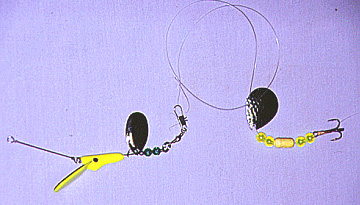 by
changing some baits. On that pass, the fish showed their preference for a
tiny, HJ8 Rapala Husky Jerk in black/gold pattern. We loaded up the
trolling spread with the hot setup and took seven huge walleyes on the
second pass. We caught (and mostly released) over 50 walleyes that day with
over half of them qualifying for Fish Ohio awards. Our success was due in
large part to precision trolling. by
changing some baits. On that pass, the fish showed their preference for a
tiny, HJ8 Rapala Husky Jerk in black/gold pattern. We loaded up the
trolling spread with the hot setup and took seven huge walleyes on the
second pass. We caught (and mostly released) over 50 walleyes that day with
over half of them qualifying for Fish Ohio awards. Our success was due in
large part to precision trolling.
The
Mechanics of Trolling
There are five factors that affect a bait's running depth: Lure design, line
diameter, trolling speed and the amount of line let out commonly referred to
as the setback all affect the depth a lure will achieve. Sinkers and
devices like Pa's or Dipsy Divers will also affect running depth by taking
lures down.
Its common knowledge that Lures that incorporate lips or bills, commonly
referred to as crankbaits, will dive down into the water more than a spoon
will. Lures with bills dive down because downward force is applied to the
lip as the lure is pulled through the water. Crankbaits will reach top
depths as long as the maximum speed of the crankbait is not exceeded. When
a crankbait is trolled too fast, it looses its bite on the water and runs
erratically.
Crankbaits must run true to dive to their maximum potential. By this I mean
straight through the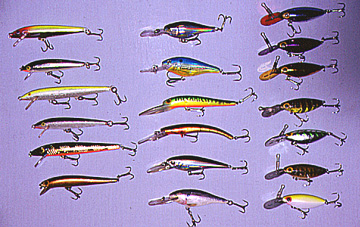 water without squiggling out to the sides. To test the tune of a crankbait,
at trolling speed, with about 6' of line out, put the lure in the water and
slowly sweep it ahead with the rod. If the bait veers to one side, bend the
eye of the lure away from the direction that the lure is tracking. Through
trial and error, the lure can be made to run straight and true.
water without squiggling out to the sides. To test the tune of a crankbait,
at trolling speed, with about 6' of line out, put the lure in the water and
slowly sweep it ahead with the rod. If the bait veers to one side, bend the
eye of the lure away from the direction that the lure is tracking. Through
trial and error, the lure can be made to run straight and true.
Lures that do not have a diving lip, like crawler harnesses for instance are
very sensitive to speed in regards to their running depth. The faster a
crawler harness is trolled, the higher it will ride up in the water column.
Line creates drag in the water, which causes a lifting affect as a lure is
pulled through the water. The thicker the line, the shallower a lure will
run. This is why thicker monofilament line will run baits higher in the
water column than thinner super lines of the same pound test. Choosing
fishing line is typically a compromise. I like to use the lightest line
possible to achieve depths with a minimal amount of line out. I
also want line
that will be tough enough to handle large, toothy walleyes. Unless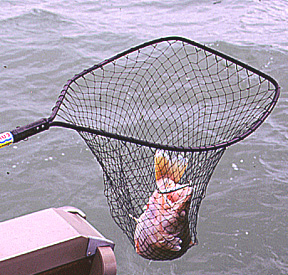 I'm running Dipsy Divers, I use Cabela's Proline exclusively and prefer
15-lbs. test clear mono on Erie. I like monofilament line for trolling
because the stretch acts like a shock absorber and keeps the hooks from
ripping out of fish. For Dipsys, I use green, Cabela's Ripcord.
I'm running Dipsy Divers, I use Cabela's Proline exclusively and prefer
15-lbs. test clear mono on Erie. I like monofilament line for trolling
because the stretch acts like a shock absorber and keeps the hooks from
ripping out of fish. For Dipsys, I use green, Cabela's Ripcord.
The setback is the easiest way to adjust the running depth of a given lure.
By letting more line out, the lure will typically run deeper. Conversely,
shortening up the setback will run the lure higher. When running crankbaits,
I always install a rubber-core sinker one rod length ahead of the lure. I
use sinkers that vary in size from 1/8 to 2 oz. They allow me to achieve
the desired depth with a minimal amount of setback.
Shorter
setbacks are desired to reduce line stretch, which improves hooksets.
Rubber-core sinkers also allow lines to be set faster and they tend to catch
lure fowling debris keeping offerings productive.
Determining
Running Depth
There are two
ways to determine running depth: Many moons ago, when I first started
fishing Erie, I was forced to learn through experimentation how deep a given
presentation ran. That painstaking process was very time consuming and
wrought with uncertainty. Fortunately there's a much better way today.
Mark Romanack and Steve
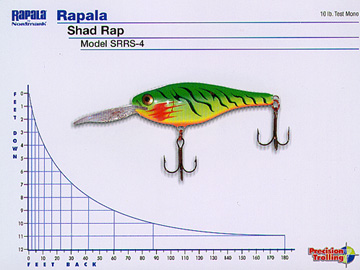 Holt
came up with the troller's bible; a book titled Precision Trolling. Now in
its seventh edition with over 200,000 copies sold, this absolute must-have
publication is a vital part of most avid walleye trollers' arsenals. The
book contains a ton of information on the art of trolling including dive
curves that detail how deep most of today's lures will run. The book also
addresses differing line diameters, adding weights and much more. Copies of
the book can be found in well-stocked tackle shops including Cabela's. You
can also order the book online at www.precisionangling.com or by phone at
800-353-6958. I keep a copy in my boat and when I need to run particular
bait at a specific depth, it's as simple as looking it up in the book and
putting the bait in their faces. If you have any questions [email protected]
is my email address. Holt
came up with the troller's bible; a book titled Precision Trolling. Now in
its seventh edition with over 200,000 copies sold, this absolute must-have
publication is a vital part of most avid walleye trollers' arsenals. The
book contains a ton of information on the art of trolling including dive
curves that detail how deep most of today's lures will run. The book also
addresses differing line diameters, adding weights and much more. Copies of
the book can be found in well-stocked tackle shops including Cabela's. You
can also order the book online at www.precisionangling.com or by phone at
800-353-6958. I keep a copy in my boat and when I need to run particular
bait at a specific depth, it's as simple as looking it up in the book and
putting the bait in their faces. If you have any questions [email protected]
is my email address. |
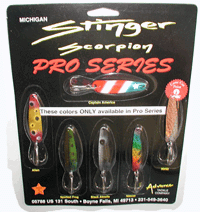
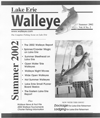




 by
changing some baits. On that pass, the fish showed their preference for a
tiny, HJ8 Rapala Husky Jerk in black/gold pattern. We loaded up the
trolling spread with the hot setup and took seven huge walleyes on the
second pass. We caught (and mostly released) over 50 walleyes that day with
over half of them qualifying for Fish Ohio awards. Our success was due in
large part to precision trolling.
by
changing some baits. On that pass, the fish showed their preference for a
tiny, HJ8 Rapala Husky Jerk in black/gold pattern. We loaded up the
trolling spread with the hot setup and took seven huge walleyes on the
second pass. We caught (and mostly released) over 50 walleyes that day with
over half of them qualifying for Fish Ohio awards. Our success was due in
large part to precision trolling. water without squiggling out to the sides. To test the tune of a crankbait,
at trolling speed, with about 6' of line out, put the lure in the water and
slowly sweep it ahead with the rod. If the bait veers to one side, bend the
eye of the lure away from the direction that the lure is tracking. Through
trial and error, the lure can be made to run straight and true.
water without squiggling out to the sides. To test the tune of a crankbait,
at trolling speed, with about 6' of line out, put the lure in the water and
slowly sweep it ahead with the rod. If the bait veers to one side, bend the
eye of the lure away from the direction that the lure is tracking. Through
trial and error, the lure can be made to run straight and true. I'm running Dipsy Divers, I use Cabela's Proline exclusively and prefer
15-lbs. test clear mono on Erie. I like monofilament line for trolling
because the stretch acts like a shock absorber and keeps the hooks from
ripping out of fish. For Dipsys, I use green, Cabela's Ripcord.
I'm running Dipsy Divers, I use Cabela's Proline exclusively and prefer
15-lbs. test clear mono on Erie. I like monofilament line for trolling
because the stretch acts like a shock absorber and keeps the hooks from
ripping out of fish. For Dipsys, I use green, Cabela's Ripcord.